ML Aggarwal Class 8 Solutions for ICSE Maths Chapter 3 Squares and Square Roots Ex 3.4
Question 1.
Find the square root of each of the following by division method:
(i) 2401
(ii) 4489
(iii) 106929
(iv) 167281
(v) 53824
(vi) 213444
Solution:
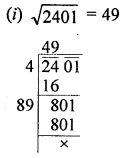

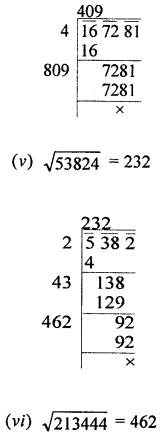
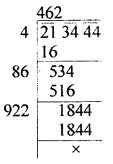
Question 2.
Find the number of digits in the square rootof each of the following (without any calculation):
(i) 81
(ii) 169
(iii) 4761
(iv) 27889
(v) 525625
Solution:
(i) 81
In 81, a group of two’s is 1.
∴ Its square root has one digit.
(ii) 169
In 169, groups of two’s are 2. Its square root has two digits. 4761
∴ In 4761, groups of two’s are 2. Its square root has two digits.
(iii) 27889
In 27889, groups of two’s are 3.
∴ Its square root has 3 digits.
(iv) 525625
In 525625, groups of two’s are 3.
∴ Its square root has 3 digits.
Question 3.
Find the square root of the following decimal numbers by division method:
(i) 51.84
(ii) 42.25
(iii) 18.4041
(iv) 5.774409
Solution:
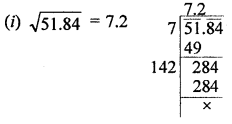
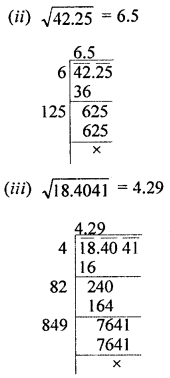
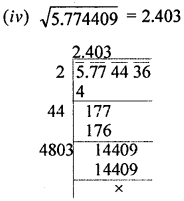
Question 4.
Find the square root of the following numbers correct to two decimal places:
(i) 645.8
(ii) 107.45
(iii) 5.462
(iv) 2
(v) 3
Solution:
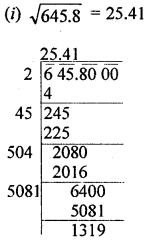
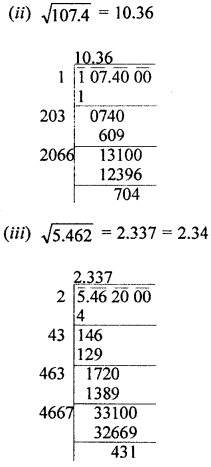

Question 5.
Find the square root of the following fractions by division method:

Solution:


![]()
Question 6.
Find the least number which must be subtracted from each of the following numbers to make them a perfect square. Also find the square root of the perfect square number so obtained:
(i) 2000
(ii) 984
(iii) 8934
(iv) 11021
Solution:
(i) 2000

Taking square root, we see that 64 is left as remainder.
∴ So, subtracting 64 from 2000
We get 1936, which is a perfect square and its square root is 44.
(ii) 984

Taking square root, we see that 23 is left as remainder.
∴ So, subtracting 23 from 984
We get 984 – 23 = 961 which is a perfect square and its square root is 31.
(iii) 8934

Taking square root, we see that 98 is left as remainder.
So, subtracting 98 from 894
We get 8934 – 98 = 8836 which is a perfect square and its square root is 94.
(iv) 11021
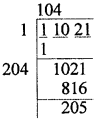
Taking square root, we see that 205 is left as remainder.
∴ So, subtracting 205 from 11021
We get 11021 – 205 = 10816
Which is a perfect square and its square root is 104.
Question 7.
Find the least number which must be added to each of the following numbers to make them a perfect square. Also, find the square root of the perfect square number so obtained:
(i) 1750
(ii) 6412
(iii) 6598
(iv) 8000
Solution:
(i) 1750

Taking square root, we see that
(41)2 is less than 1750
So we take (42)2, we get
164 – 150= 14 less
So by adding 14, we get a square of 42 which is 1764.
(ii) 6412

Taking a square of 6412, we see that (80)2 is less than 6412.
So, we shall take (81)2 and we get
161 – 12 = 14 less
So, by adding 149, we get a square of 81 which is 6561
(iii) 6598

Taking the square root of 6598, we see that (81)2 is less than 6598.
So, we shall take (82)2 and we get
324 – 198 = 126 less
By adding 126, we get a perfect square 6724
which is square of 82.
(iv) 8000

Taking square root of 8000, we see that (89)2 is less than 8000.
We shall take (90)2 = 8100
which 8100 – 8000 = 100 is less
So, by adding 100 we get (90)2 = 8100 which is a perfect square.

Question 8.
Find the smallest four-digit number which is a perfect square.
Solution:
Smallest 4-digit number = 1000

Taking square root, we see that 39 is left.
If we subtract any number from 1000 we get a 3-digit number.
So, we shall take (32)2 = 1024
So, 1024 – 1000 = 24 is to be added to get a perfect square of a least 4-digit number.
Hence required 4-digit smallest number = 1024
Question 9.
Find the greatest number of six digits which is a perfect square.
Solution:
Greatest 6-digit number = 999999
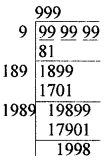
Taking square root of 999999, we see that 1998 is left
∴ Subtracting 1998 from 999999 we get 998001 which is a perfect square.
Hence, required 6-digit greatest number = 998001
Question 10.
In a right triangle ABC, ∠B = 90°.
(i) If AB = 14 cm, BC = 48 cm, find AC.
(ii) If AC = 37 cm, BC = 35 cm, find AB.
Solution:
(i) In right angled triangle ABC
AB = 14 cm and BC = 48 cm
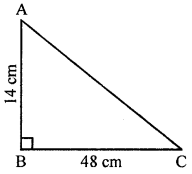
∴ AC2 = AB2 + BC2 (Pythagoras Theorem)
= 142 + 482
= 196 + 2304 = 2500
∴ AC = \(\sqrt{2500}\) = 50 cm

(ii) In ∆ABC, B = 90°
AC = 37 cm, BC = 35 cm
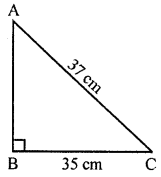
AC2 = AB2 + BC2 (Pythagoras Theorem)
372 = AB2 + 352
1369 = AB2 + 1225
AB2 = 1369 – 1225 = 144
AB = \(\sqrt{144}\) = 12 cm

Question 11.
A gardener has 1400 plants. He wants to plant these in such a way that the number of rows and number of columns remains same. Find the minimum number of plants he needs more for this.
Solution:
Total plants = 1400

Number of columns = Number of rows
Now, taking the square root of 1400,
we see that (37)2 < 1400
∴ We shall take (38)2 = 1444
So, we need 1444 – 1400 = 44 plants more
Hence required plants = 44
Question 12.
There are 1000 children in a school. For a P.T. drill they have to stand in such a way that the number of rows is equal to number of columns. How many children would be left out in this arrangement?
Solution:
Number of total children in a school = 1000
For P.T. drill, the children have to stand in such a way that.
Number of rows = Number of columns
Now take the square root of 1000,
we see that (39 left as remainder).
∴ Left out children = 39

Question 13.
Amit walks 16 m south from his house and turns east to walk 63 ra to reach his friend’s house. While returning, he walks diagonally from his friend’s house to reach back to his house. What distance did he walk while returning?
Solution:
Amit walks 16 m south from his house at then turn to east 63 m.
O is the house and A and B are the places.
OA = 16 m, AO = 63 m
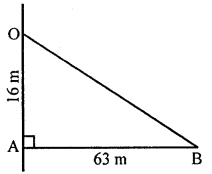
∴ OB2 = OA2 + AB2
= 162 + 632 (Pythagoras Theorem)
= 256 + 3969 = 4225
∴ OB = \(\sqrt{4225}\) = 65

∴ He is 65 m from his house.
So, he has to walk 65 m to reach his house.
Question 14.
A ladder 6 m long leaned against a wall. The ladder reaches the wall to a height of 4.8 m. Find the distance between the wall and the foot of the ladder.
Solution:
Length of a ladder = 6 m
It reaches the wall at a height of 4.8 m
∴ AB is the ladder and AC is the height of the wall
∴ AB = 6 m, AC = 4.8 m
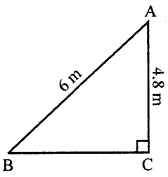
Now the distance between the foot of the ladder and the wall is BC Now,
AB2 = AC2 + BC2 (Pythagoras Theorem)
⇒ 62 = 4.82 + BC2
⇒ BC2 = 62 – 4.82 = 36 – 23.04 = 12.96
∴ BC = \(\sqrt{12.96}\) = 3.6 m
